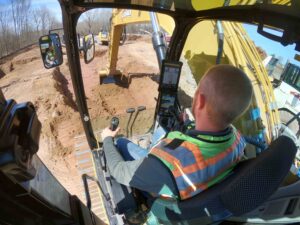
Adopting construction technology
By Stantton Pallister
Construction Equipment Equipment TechnologyWhen it comes to working with technology and data, it is no longer a question of ‘if’ but when and how much.
Our ever-evolving world is driven by technology and data, so it might come as a bit surprising that not everyone has fully embraced these advancements. Even among those who have embraced technology, there’s still room for improvement to make the most of the powerful information at their disposal.
For technology to become more than an on-site tool for heavy equipment and machinery, the entire business needs to maximize the investment and use all the data and information. There are ways to facilitate digital transformation, so that more companies can harness the full potential and be more competitive.
BREAKING THE ADOPTION BARRIER
Some long-time, multi-generational contractors have built successful businesses using proven methods. They understand their business and their machinery very well, and to them, technology can be seen as more of a challenge than a support.
While change can be uncomfortable, making the leap means opening the door to invaluable data and insights. When companies decide to accept technology, they eventually realize it’s not as difficult as it might seem—and the impacts are real.
When used effectively, technology can bring a 20 to 30 per cent improvement in efficiencies. Construction technology improves data collection, which then drives decision-making quality and agility, highlights inefficiencies, and boosts productivity while reducing labour. It bridges management between departments and that strengthens partnerships. It becomes part of your business strategy—a trusted advisor for your business.
APPEALING TO THE NEXT GENERATION
Younger professionals entering the industry are also used to technology. It’s been a constant tool in their lives. In fact, they expect it. Even seasoned employees, rarely want to go back to traditional methods after a taste of technology, and for good reason.
It’s a competitive edge for realizing better margins, more accurate estimates, and proposals that drive more wins. Complicated tenders see risk and runtime reductions. Technology aids in shortening construction schedules and reducing rework. The results are improved quality and sustainability.
MAXIMIZING THE OPPORTUNITIES
Even when adopted, we are finding that many companies are only using about 40 per cent of gathered data. There is so much room for growth. The use of descriptive, predictive and prescriptive analytics holds the key to maximizing your return.
Descriptive analytics are used to track what has already happened. How much earth was moved, how much fuel was consumed, etc. It’s a great starting point.
Once you start to accumulate descriptive data you can take the information to the next level, predictive analytics, where you can use technology to predict and plan for requirements for the site tomorrow, next week, or even next month. How much earth do you expect will be moved? Predictions are made based on what is known.
Building from that base, prescriptive analytics analyze options to show a company best choices when bidding, based on the data collected from past work.
As construction technology advances, so do the data analytic possibilities. It’s exciting to see companies evolve and grow while improving efficiencies, transparencies, and social benefits within a community.
Stantton Pallister is the sales and operations manager with SITECH Western Canada.





